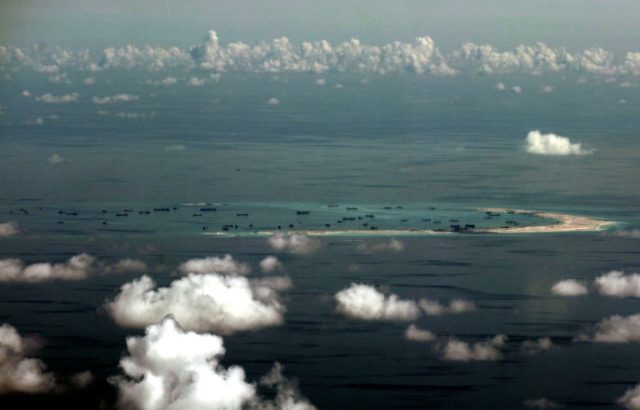The Philippine Daily Inquirer on Monday published photos showing the breathtaking extent of Chinese military construction on disputed reefs in the Spratly Islands area of the South China Sea.
The Inquirer presents the aerial photography as evidence that China is almost finished transforming the reefs into an “island fortress” for the purpose of controlling the entire region.
“Most of the photos, taken between June and December 2017, were snapped from an altitude of 1,500 meters and they showed the reefs that had been transformed into artificial islands in the final stages of development as air and naval bases,” the Inquirer wrote, listing seven reefs that will soon have fully operational Chinese military bases. Airfields, radar domes, missile shelters, communications antennas, and hangars have been spotted on the artificially enhanced islands.
The photos were shown to Eugenio Bito-onon Jr., formerly mayor of a town on the largest Spratly island occupied by the Philippines. He pronounced them authentic and said they clearly showed extensive Chinese development that was not present during his last overflight two years ago. He recalled the Chinese warning his plane to move away from the islands on that occasion.
Among the many problematic features of China’s effort to fortify the reefs is that one of them, Panganiban, clearly lies inside the Philippines’ exclusive economic zone, and was ruled a Philippine possession by an international arbitration court at the Hague. China has resolutely ignored this decision since it was handed down.
China also made an agreement with the Association of Southeast Asian Nations (ASEAN) not to artificially enhance reefs in the area, but that agreement clearly means little to Beijing either. The Inquirer quotes a spokesman for Philippine President Rodrigo Duterte to the effect that as long as China does not reclaim any more islands, the Philippines will accept Chinese militarization of the Spratlys.
Antonio Carpio, an associate justice of the Philippines who argued before the Hague, strongly criticized this attitude. Carpio compared it to relying on the good faith of a thief who is attempting to break into your house.
“You’re in a fantasyland. That’s not how the world is put together. That’s not realpolitik,” he said, warning that China’s military development could permanently compromise the national security of the Philippines.
Other critics quoted by the Inquirer warned that Duterte is compromising Philippine interests to obtain loans from China that will only put his country more firmly under Beijing’s thumb, and worried that Duterte made a fatal error by declining to press his legal case against China with ASEAN and the broader international community. A good 80 percent of the Philippines’ economic zone could end up being annexed by China, putting the vital Filipino fishing industry at the mercy of the Chinese.
The Inquirer’s photos include a snapshot from December 30 that shows three Chinese military transport vessels docked at Panganiban, all capable of carrying troops and weapons. Another Chinese installation on McKennan Reef is sporting a 100mm artillery piece. Several Chinese warships have been spotted in the area as well.
The UK Guardian quotes a Chinese response to the Inquirer photos that largely consists of insisting that most of the facilities constructed in the Spratlys are civilian in nature.
The Philippine government said on Tuesday that it is “assessing” the photos provided by the Inquirer, which have been described as the most extensive photographic evidence of Chinese activities in the South China Sea to date.
“So what are the purpose of those structures?” asked National Security Adviser Hermogenes Esperon Jr. “They could be for civilian use, but we should look to possibilities that they could be used against us. If they are for military use, then that is something that we should look into.”
Esperon said there is an “array of options that we can take,” including diplomatic complaints or moving more troops onto Philippine possessions in the region. He grew exasperated over doubts that such measures would amount to much when China is building island fortresses in the Philippines’ maritime backyard.
“What do you want us to do? Go to war? What do you want us to do? We have been studying it. We have done some actions. But are you asking us to go to war? There are actions that we are doing,” he exclaimed to reporters.
The rest of ASEAN weighed in on Tuesday from a meeting in Singapore, where the organization said note was taken of “concerns expressed by some ministers on the land reclamations and activities in the area, which have eroded trust and confidence, increased tensions and may undermine peace, security, and stability in the region.”
ASEAN ministers were nevertheless optimistic that negotiations with China to write a “code of conduct” for the South China Sea would be productive. It is a mystery why anyone thinks Beijing would honor such a code more than its promises not to do exactly what it has done in the Spratlys, or a court ruling that legitimized Philippine claims to some of the reefs China has transformed into military airbases.

COMMENTS
Please let us know if you're having issues with commenting.